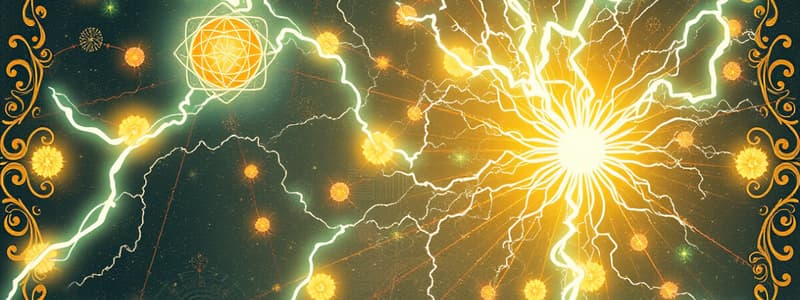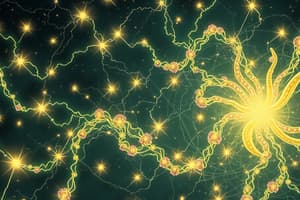Podcast
Questions and Answers
What direction do cations move when electrodes are placed in a solution?
What direction do cations move when electrodes are placed in a solution?
- Toward the cathode (correct)
- Toward the anode
- In all directions equally
- No movement occurs
What is the conventional current flow direction in a circuit?
What is the conventional current flow direction in a circuit?
- Positive to negative (correct)
- Randomly throughout the circuit
- Negative to positive
- No established direction
Which law explains the conservation of charge in an electrical circuit?
Which law explains the conservation of charge in an electrical circuit?
- Ohm’s Law
- Faraday's Law
- Kirchhoff's first law (correct)
- Ampere’s Law
What is mean drift velocity in the context of electron movement in metals?
What is mean drift velocity in the context of electron movement in metals?
How does the number density of electrons affect their velocity in a conductor?
How does the number density of electrons affect their velocity in a conductor?
What is the SI base unit for electric current?
What is the SI base unit for electric current?
How is the net charge on a particle calculated?
How is the net charge on a particle calculated?
Which statement correctly describes electric current in metals?
Which statement correctly describes electric current in metals?
What happens to an atom when it loses electrons?
What happens to an atom when it loses electrons?
Which of the following best describes charge in terms of elementary charge?
Which of the following best describes charge in terms of elementary charge?
Which of the following is an example of a conducting liquid?
Which of the following is an example of a conducting liquid?
What determines whether a particle is positively or negatively charged?
What determines whether a particle is positively or negatively charged?
What is the definition of electric current?
What is the definition of electric current?
Study Notes
Charge and Current
- Electric current (I) is defined as the rate of flow of charge, expressed mathematically as I = Q/t, where Q is charge and t is time.
- The SI base unit for current is Amperes (A). An ammeter measures current and must be connected in series within a circuit.
Charge
- Charge (Q) is a physical quantity that can be positive or negative, measured in coulombs (C).
- 1 coulomb (C) represents the flow of 1 ampere over 1 second (1 C = 1 A·s).
- Charge values are quantized: a proton has a charge of +1 (1.6 x 10^-19 C) and an electron has a charge of -1 (1.6 x 10^-19 C).
- In neutral atoms, the number of protons equals electrons, resulting in no net charge. Adding electrons creates negative ions, while removing them creates positive ions.
- The net charge formula is Q = ±ne, where n is the number of electrons added or removed.
Charge Carriers
- Electric current involves charge carriers that vary by material type; electrons typically carry current in metals.
- Metals have a lattice of positive ions surrounded by free-moving electrons. When an electric field is applied, electrons move toward the positive electrode, creating current.
- Electrolytes, such as ionic solutions, allow charge conduction via positive and negative ions. For instance, saltwater (NaCl in H₂O) dissociates into Na+ cations and Cl- anions, which move towards their respective electrodes, generating current.
Conventional Current
- Conventional current was established before electron discovery and is defined as the flow of charge from positive to negative terminals, irrespective of the actual movement of electrons.
- In metals, electrons flow from negative to positive, resulting in electron flow opposite to conventional current direction.
Kirchhoff's First Law
- Kirchhoff’s first law dictates that at any junction in an electrical circuit, the sum of currents entering equals the sum of currents leaving the junction, reflecting the conservation of charge.
- This reinforces that charge cannot be created or destroyed, reinforcing its conservation as a fundamental property.
Mean Drift Velocity
- Mean drift velocity (v) defines the average velocity of electrons moving through a conductor, which varies due to collisions with positive metal ions.
- When connected to a power supply, electrons are attracted to the positive terminal but still experience these collisions, which affect their overall motion.
- Number density (n) indicates the number of free electrons per unit volume. Conductors like metals possess high number densities (around 10²⁸ m⁻³), while insulators have lower densities, requiring faster electron speeds to maintain the same current level.
Studying That Suits You
Use AI to generate personalized quizzes and flashcards to suit your learning preferences.
Description
This quiz focuses on Topic 4.1 of the OCR A-level Physics curriculum, covering the concepts of electric charge and current. Explore the definitions, units, and measurements related to current, including its rate of flow and the significance of Amperes.




